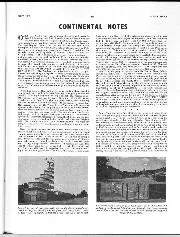
Continental Notes, July 1957
Only last April I was writing about the growing interest in Grand Prix racing and how Formula 1 events were filling the calendar thick and fast. I pointed out how the…
EDITORIAL.
THE M.C.C. DECIDES.
THE M.C.C. are in future going to ban the use of competition tyres in their trials ! This news, suddenly announced a few days before Christmas, gave rise to much heated discussion during the holidays whenever motor-sportsmen met, and now that the first fury of the battle is over a brief survey of the position may help to clear the air a little.
Take the two opposing schools of thought. First, those who are against the use of competition tyres say that they serve exactly the same purpose as chains, which have been banned long ago. This appears completely logical, but it is only fair to point out that the holders of this view are in many cases the drivers of small, light cars which can gain speed sufficiently on the lower slopes and corners of a hill to enable them to keep going over a slippery stretch. The strongest members of this section are, of course, the owners of cars with a solid rear axle, which are practically immune from wheel-spin and therefore have no need either for elinins or special tyres. Now for the other side of
the picture. Those in favour of competition tyres claim that in this way they are able to put their heavier cars on more level terms with their rivals. They contend that without” comp.” tyres certain hills, such as Iles Lane, are definitely tinclimbable, when wet and muddy, with anything but a special type of small sports car, and that unless trials are to degenerate into events for this form of motor-car alone, competition tyres must be allowed.
The result is a deadlock. Each side, it will be seen, is influenced by the type of car which its members drive.
The former, being able to dispense with competition tyres, would like to see this advantage given the fullest recognition. The latter do not see why all types of cars, intelligently lisiidled, should not be allowed to stand an equal chance of success, and they object to a feature like the solid axle (a principle which is not suitable for large cars) being placed at such an advantage.
It cannot be denied that competition tyres have gained ground as a result of Man’s incurable urge to dodge regulations. “If we are not allowed to put chains on our tyres, we will have tyres which have knobs on already,” seems to be the spirit, and as such must be discouraged. The obvious solution to the problem is that the neces sity for chains or “Comp.” tyres should be removed by the elimination of all hills which without their aid are impossible to climb. This is a tall order, we know, but its partial accomplishment is at any rate possible. The weather is unfortunately the deciding factor in many cases, but hills which are only formidable when wet might well be avoided. Modern sports cars, with a well chosen can. sur can. surmount most gradients, and a general tightening of stop and restart, acceleration and
braking, and timed section tests, appear to be the best means of deciding awards. The position of reli
ability trials has steadily become more confused in recent years. Dissension is rife among competitors as to the fairest tests which should be included, and we should like to congratulate the M.C.C. on bringing the matter to a head. If fine weather prevails during the Land’s End Trial at the end of March, the competition tyre controversy should be finally settled.